 |
Scenic Line Members' Reports 25 December 2010 |
|---|
PONCHA JUNCTION
Narrow gauge track painting has invaded the Junction! The difference between painted and silver pristine track is
incredible. The first coat of Floquil Rail Brown has been applied (a kind of greenish-muddy brown). Next, rust will be
added to give the rail more color. After that, ties will be painted with various colors. The Floquil track pen set is
being used mostly for this, with 2 pens pretty much depleted, but make the job go pretty easily. The frogs, guard rails,
and tight spots where the pen tips don't fit are being painted with Humbrol paints by brush, which is not bad if you don't
have to do dual gauge switches, which require a lot of hand painting. This is resulting in an excellent blend of color
and variation of the rail and ties.

MONARCH
Bragdon foam scenery bed is being installed along the Monarch switchback down to Mear's. Still a long way to go, but
finally in progress again. Now that we have all these trees, it is time to get seriously working on the scenery.


GRAYS
Near the Gray's Water Tank site, some experimantal scenery was begun. It was decided to procure some light reddish
orange dirt for the cut. Track painting is underway from Marshall Pass to Mear's Jct and beyond.


MARSHALL PASS
A six inch section of track and cork roadbed has been cut out where the rails had buckled from expansion, on the "inside"
track. A piece of luann will be inserted with ties, so the ends to the flex track can be spiked and a splice of handlaid
can be spiked. Another spot where the track kinked is near the Marshall Pass Water Tank, where another splice is planned.
MORE NEWS

WORKSHOP - PINE TREE MAKING - Jacob Lofgren
Jacob gave us a very instructional and fun workshop learing about and making several types of trees for the layout. We
learned of the different types of trees needed for the layout, the different types of pines that grow at the various
elevations, where we would need to plant them on the layout, and avoid simply making the coolest or most popular trees,
and instead modeling the right types of trees, types pf pine specifically, for the subject of today's clinic. Jacob
explained the types of pinon pine, juniper/cedar and firs at the sub-moraine level, & ponderosa, lodgepole, & firs at the
higher elevations. Jacob also went through the costs and time required for different types. Jacob showed us pictures of
trees and of layouts with examples of different types modeled/displayed. We then each worked at different tasks, from
painting trunks, adding filter screens, trimming "branches", painting wash on (114) Scenic Woodland pinon & juniper trunks.






CLEORA
Hal planed off an area between subroadbed areas. The boards are laid at various grades to match the original roadbed.
The outside DG track roadbed around the pens will require some shimming for leveling.
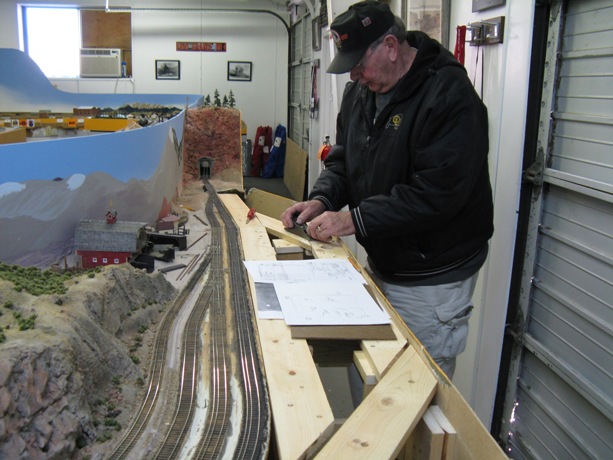
GRAYS
Sections of the narrow gauge track are now finally being painted. Only the initial application of Rail Brown has been
applied (at below left), the difference with unpainted rail (below right). Floquil enamels are used (so they aren't
washed off with wet glue and alcohal). Rust will be added to the rails, and then ties will be painted with Rail Tie
Brown and various other colors (grays/browns).


MARSHAL PASS
After all these trees are complete, they will need planting so we don't need to store tons of trees. Realizing this, we
need some place for planting. This means we need to get the ground complete for planting. Well, trees really go in last,
and the dirt also doubles as ballast for most of the narrow gauge, so before we can even put dirt in, we really need to
have track ready. So the priorities are to get all track kinks fixed, and track and ties painted. We still have a lot of
areas where there still isn't even any ground. So next month's workshop may be to have everyone painting track & ties.
All track in view below (with exception of parts of the switches) has a initial coat of Floquil Rail Brown.

OPERATIONS
The dispatcher panels were removed for completion (below) while scenicing is underway. Trains are designated with
markers with Train numbers (east or West, std or Narrow Gauge), and are moved by the Train Conductor OS-ing at a designated
hand-set location. The Dispatcher can move the marker to the OS location and provide clearance for the Train. We'll
have a clinic on operations in the future when hand sets are installed. Some of the lines displayed on the panels aren't
are for display only. The tracks are sized to easily accommodate the train magnets. Changes can easily be made since all
the lines and names are by stick-ons.



MORE NEWS
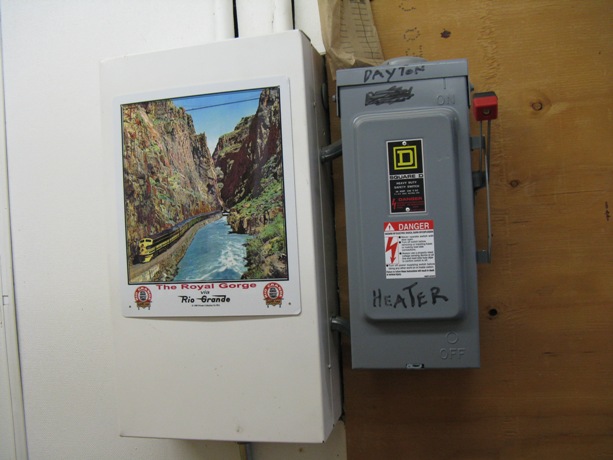
CLEORA
Risers are being trimmed to sit flush with the bottom of the benchwork.
CIMARRON
The drop shelf was hung off the back wall shelf. Plans for the stock pens are in work. Most of the roadbed has been
installed, with the rest awaiting the drop shelf to be completed. Checked out some donated NG switches for the yard,
but unfortunately are closer to No.5 than the planned No. 6s already laid out. Ties will be laid when new switches are
available.
TREE-MAKING
More tree making. Next week Jacob will set up the tree workshop where we will take turns at each step of making trees.
OPERATIONS
Dirt and talus is being applied around and above the Dispatcher desk, in preparation for some of the trees being made.
Track and ties need painting, culverts, water and ballasting, and the backdrop will need painting as well before the final
planting. This area needs completion so the Dispatch panels can be re-installed and not get spattered by scenery work.
The 1st of 3 dispatcher panels was completed, which contains the track schematic from Montrose, Cimarron, Gunnison, Crested Butte, Parlin, Pitkin, and Shavanno. The final panel arrived in the mail Thursday, so these should be complete soon.
The plan for the dispatch communications were laid out. Hand-sets are planned for Salida (2), Poncha/Monarch, Marshall Pass, Gunnison, Crested Butte/Portland, Helix, Parkdale, and Cleora for a total of 9. A headset will be used for the Dispatcher, which avoids a buzzer there. A buzzer will be needed for the Salida Yardmaster. Eventually, it is hoped we will add operating semaphores at Parkdale and Poncha (which will help reduce some dispatch chatter).
MORE NEWS
Tree-Making
Jacob keeps making spectacular trees. In two weeks, we'll have a workshop where we will all sit down and make trees
following our monthly breakfast.


CIMARRON
The "S" curve going into the Gunnison Freight House lead is eliminated by removing the far right track, and switching to
the Gunnison main by using a RH switch. The run-around and stock track lead was moved to cut off the end of the right
yard track, thereby eliminating a crossover and using a LH switch. The prototype had a tail off the middle track,
probably a 3-way stub, for the run-around. We will use all point switches.

MONTROSE
The yard throat was redesigned to accomodate the Cimarron yard lead. The remaining Montrose staging yard roadbed was
completed today.


DCC
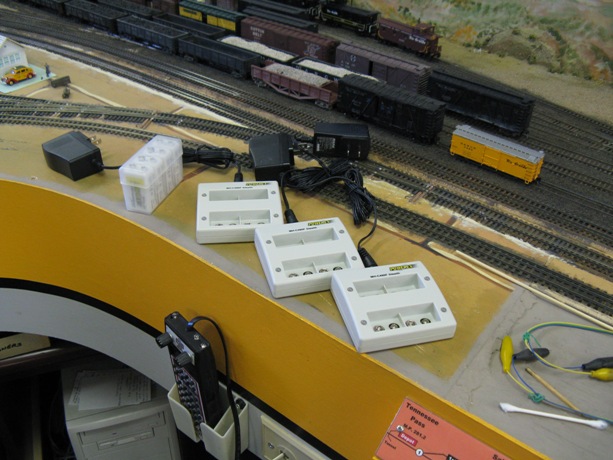
CLEORA
The subroadbed has been installed. The old switch panel is temporarily held in place with a clamp. The next phase will
be to remove part of the first mainline and relay the outer track as soon as new switches are available for installation.
Roadbed will be cut out of luann plywood, but the mainline will be adjusted for the installation of a straight switch,
thus alignment will be made with the switch when available.

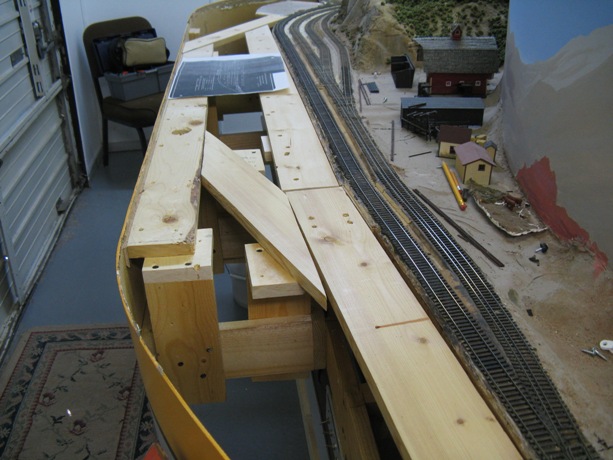
CIMARRON
The new town of Cimarron has been added to the Montrose staging deck. Cimarron features a 3 track yard, water tank and
depot and freight house (available from Bollinger Edgerly Scale
Trains). A preliminary track plan is shown below. A few modifications still needed.

MONTROSE
The first 21.5 ft of roadbed has been installed. Next step was to determine the Cimarron trackplan before completing the
yard lead, etc.
Other News

CLINIC - CONSTRUCTING D&RGW WATER TANKS - Harold Zimbelman
Hal gave us a very insightful and entertaining treatise on Water Tank construction. Hal covered the various differences
seen in several D&RGW tanks and kit types. Hal explained the advantages and disadvantages among the different tank kit
manufacturers (Campbell, Walthers, Crystal River Products, Durango Press, Timberline, and Simba). Hal showed us some
different strategies which improved and simplified construction of the tanks. We had a lot of fun for our first clinic
in our "Modeling Education Series".



CLEORA
The subroadbed sections have been cut out and several risers have been made, to ready installation. The fascia screws
were reset and countersunk. The Sanborn map laying across the subroadbed pieces, shows the actual stockpen arrangement.
The stockpens were serviced with dual gauge tracks on each side. The siding off the dual mainlines was dual gauge with
5 combination loading chutes for standard gauge. Another dual gauge track serviced the rear of the stockpens, with
3 combination unloading chutes for narrow gauge and 3 combination unloading chutes for standard gauge. Because of space
limitations, we plan to alter the basic pen plan to look and operate similarly, with 3 standard gauge combination loading
chutes, 3 narrow gauge combination unloading chutes, and 1 standard gauge combination unloading chute. A combination
chute has 2 ramps, 1 for an upper deck car.

MONTROSE
The fascia was put in proper placement, screws reset and countersunk. Several pieces of narrow gauge roadbed, cut out of
luann plywood on the table saw, had centerlines marked, in preparation for installation at Montrose. The end of the
extension near the back door will be Montrose staging, with 4 tracks. The other end across the aisle from Gunnison, will
be Cimmarron, with a Depot, Tank, Freight House and stockpen. Bollinger Edgerly Scale Models now makes the Cimarron
freight house as well as the depot, in HO scale.
The 4 tracks are expected to stage (1) the Shavanno passenger train (from Montrose-Salida), (2) a stock train (Montrose-
Salida), (3) a mixed freight (Baldwin-Gunnison), and (4) a freight (Montrose-Salida).

Tree Making
Jacob has been working on these trees for a little while, and today painted the bark using an acrylic and then washing
with a stain. Next month we'll be having a tree-making workshop in lieu of a clinic.





Other News
CLEORA
The Cleora benchwork extension was put in place. The existing fascia was used to wrap around a 10" extensions and a
new piece of fascia (~8") spliced into place. The extension will allow for a series of stock pens to be serviced by a
siding. Although the original stock pens had a siding on each side; unfortunately the extension is not wide or long
enough to have a siding on each side. The main aisle has been reduced to 30".


MONTROSE STAGING
Fascia was installed on the Montrose staging deck - with the end piece temporarily installed while the curve "cures".


2011 Officers
As Kent has been AWOL for quite awhile, Gary has been elected President. Grant continues as Secretary and Gary also
double times as Treasurer.
2011 Clinics/Workshops
Starting next month, the club will begin monthly clinic/workshops to formalize educational model railroading topics
which will be advertised to the Lockheed Martin employees/pensioneers. Not only will this be an important growth area for
club members to learn and present, but will also provide us a valuable recruiting tool. Our first clinic will be on
Construction of Denver & Rio Grande Water Tanks by Hal, November 13th, 10 AM at the Hunting & Fishing Clubhouse Bldg M41.
NMRA Membership
Because of our fortunate "escape" from the recent fire along the hogback, the group has decided to assume NMRA status to
enable the club to be covered by NMRA insurance. To cover the cost of memberships, club members' NMRA membership cost will
be covered from their regular club dues ($39/year). Current NMRA members will be credited $39 dues and new NMRA members
will receive NMRA RailPass rates at $9.95 for 6 months (which includes the NRMA Magazine). Re-enrollment at regular
annual rates will not include the $15 subscription rate for the magazine (which can be the member's choice). NMRA
insurance will provide the club insurance for disasters like theft, vandalism, fire, etc., including during club official
activities like operating sessions, layout tours, and open houses. Hopefully we would never need the insurance, but the
fire came a little too close this time, and we were lucky to not get any damage.
ROYAL GORGE ROUTE
Barry continued work on relocating the Parkdale siding/Royal Gorge switch toggle.
OPERATIONS
Grant ran some narrow gauge to continue testing track and switches; first ran stock cars from the Salida narrow gauge yard
to the Gunnison yard, then ran empty gons from the Salida Barrel to Crested Butte, then ran gons down from the Monarch
mine to the Barrel. For all of those, Blackstone K-27 s were used and for the most part had no issues.
LAYOUT STATUS
Work continues to clean and test the rails in preparation for the convention layout tours later in July. If you ve not
been out lately, the space has a new look. As your slacking secretary said last night, between the cleaning, and me
wearing my glasses, it looks totally different! Many of the bookcases and cabinets have been removed and replaced by
low cabinets and storage trays that reside under the benchwork, leaving the aisles around the periphery of the layout
much less cluttered. Also, there are now many more photos and rail memorabilia items on display, including EMD name
plates mounted to the wall, and a shelf supporting some of the donated lanterns and padlocks.
Alex has made great strides in the Monarch Mine area. He has done a great job cutting blue foam, and painting the area against the backdrop for the mine tailings. Gary has continued his work troubleshooting wiring and fixing switches to get the layout in good operating order. Your slacking secretary started ran both narrow gauge and standard gauge locos in the Salida yard to test the operability of that part of the layout. Critical items found from that testing have been fixed by either Gary or Barry, much thanks to both. Also of note, Gary and Alex have created the ground contours from Mears Junction to Marshall Pass using the Bragdon.net foam. Andrew was smoothing over seams and filling gaps with sculpt-a-mold yesterday in preparation for painting the ground in that area.
OPERATING SESSIONS(...and there was much rejoicing...)
Now that we have the narrow gauge connected through, we are going to start operating sessions again. Our thought is to
do small amounts of work on scenery, and track testing (and track fixing if necessary) on Wednesday evenings, followed by
running trains on Saturdays for the foreseeable future.
So, if you ve not been out to the clubhouse lately, drop by. Bring your camera; bring your locos and rolling stock; but
at least stop by.
Sincerely, Your Slacking Secretary
Salida
Gary and Barry completed connecting the switch motors, new switch panels, LEDs in all of West Salida. Mostly, testing and
refining of the turnouts is now the order of the day, which means we just need to run locos and trains and fine tune. The
fascia still needs patching, painting, and a new throttle socket needs to be installed. Some photos of the panels are
on the layout construction page.
Mear's Jct
Some of Jacob's handiwork. Now, this is the last section of track to reinstall on the narrow gauge.

Monarch
Hal's been sculpting back the tailings, and working the ground around the Monarch CF&I mine.



Equipment Roster
Gary added Caboose 01507 Off-centered Extended Vision Caboose in mid-seventies livery for his "Fantasy-Ops" Tunnel-Motor
coal train. This is an Atlas model, RTR, with KaDee coupler replacements only. Floquil Rail Tie Brown and burnt sienna
acrylic used on the trucks and wheels. Bragdon rusts were used on the roof, stovepipe, walkways, end platforms and steps,
while light brown was used for dust on the sides, ends, and bottom. Some soot powder was added on and around the
stovepipe as well. Very light applications of Dullcote were applied before and after the Bragdon powders were applied.
This also resulted with a light 'dusting' of the windows, which helps disguise the unfinished interior.
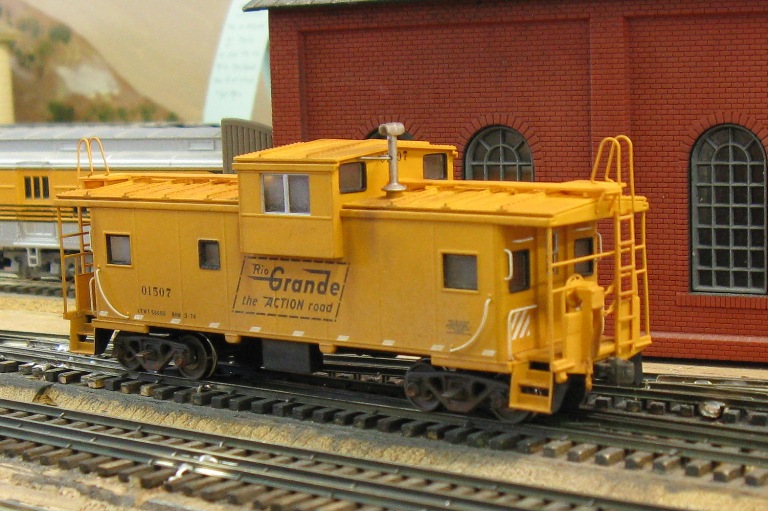
Salida
Gary connected up the LED on the Royal Gorge Route switch (SG) main for the line coming from Tennessee Pass, and started
the next DG switch/motor hook-up on the NG main. Grant checked out switches with his Blackstone, and we removed some
tight spots and improved the notch for the points to alleviate 'bumps'.
Mear's Jct
Jacob added more scenicking to the trestle downgrade bank.
DCC
Barry reconnected the Scenic Line at Poncha Jct to the reinstalled PM4 in West Salida. He also reconfigured the Gunnison
and Crested Butte wyes to the PM4, to the two unused blocks at West Salida. This was necessary to isolate one leg or tail
of each of those wyes, since they continued to experience problems with the FOBs.
Equipment
Much sweating, grunting and groaning on Jacob's mogul, which experienced decoder issues and is back in the shed.
Dispatch
Some amenties were added to the "Dispatcher's office, with fancy warning track tape and "entrance' and 'Exit' signs.
Salida
Gary and Grant have been testing out the new track in W. Salida, removing tight spots in the new switches and connecting
dead rails. Gary has installed new switch panels in Barry and Kent's style with the red and green lines, but
showing a schematic including the D&RGW actual track # and positioning the LED on the schematic, so the color of the
LED matches the schematic color. The toggle is below the schematic, some with additional graphics for clarity. White
panels are used for the NG Scenic Line, and Orange for the SG Royal Gorge Route. The panels are distributed to each
switch as recommended by Steve, so the toggle is directly opposite the turnout.
Mear's Jct
Jacob has built up a berm for the downgrade end of the trestle, and started adding rocks and paint.
Monarch
Hal has been sculpting the scenery around the CF&I mine, fitting in the bridge, and working on the tailings.
Crested Butte
Barry found a short on the Gunnison wye where the gap had grown together, and is reconfiguring the FOB to the PM4 for
autoreverse.
Dispatcher Desk
Gary has been upgrading the Dispatcher "Hole" in the Marshall Pass loop, adding some masonite "lining" for the entry
and interior.
General
Mear's Jct
Jake's been working on the scenery on the opposite end of the trestle.
Crested Butte
Barry completed the repositioning of the helix reverse loop and the Crested Butte hatch.
General
Mear's Jct
Jake's continued working on the scenery around the trestle and creekbed into the backdrop.
Gray's Siding
Gray's? News never comes from here! But in this case, it was found that the scenery needed to be installed before the
area at the Marshall Pass summit (between the track and the fascia) due to reach limitations. So far, only the webbing to support
the foam around the tank for the cut and the slope has been installed by Gary. The curve around the tank is opposite
the prototype, but the slope and cut are being modeled as shown in the "Trails Among the Columbines".




Marshall Pass
Gary has been adding the basic froming webs to lay the geodesic foam to form the mountainsides along and over the pass.
The web provides the shape and intial support for the foam, which when dried, holds it's own rigidity. The web does not
structural support and can be removed later if necessary. The web allows access from below for shaping the foam, which
can be reheated with a hair dryer for additional shaping even after the foam sits for days. The heat softens the foam
which can then be repositioned. Eventually, the foam will 'cure' and be a tough, durable surface like the mountain that
was made at Cleora.




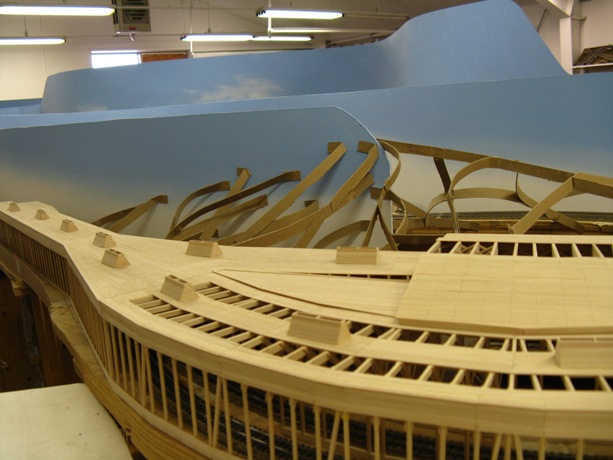



Crested Butte
Barry has been making new roadbed for the Helix reverse loop under Crested Butte so that track can be repositioned to
allow for a "hatch" in Crested Butte.
General